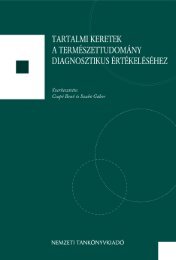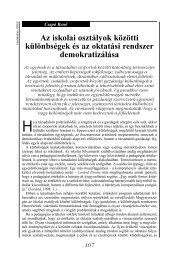értekezés - Neveléstudományi Intézet - Szegedi Tudományegyetem
értekezés - Neveléstudományi Intézet - Szegedi Tudományegyetem
értekezés - Neveléstudományi Intézet - Szegedi Tudományegyetem
You also want an ePaper? Increase the reach of your titles
YUMPU automatically turns print PDFs into web optimized ePapers that Google loves.
Bamberger, J. (2000): Music, math and science: towards an integrated curriculum. Journal of<br />
Learning Through Music, 2. 32–35.<br />
Bamberger, J. és diSessa, A. (2003): Music as embodied mathematics: a study of a mutually<br />
anforming affinity. International Journal of Computers for Mathematical Learning, 8.<br />
123–160.<br />
Bamberger, J. (2005a): What develops in musical development? In: McPherson, G. (szerk.):<br />
The Child as Musician. Oxford University Press, Oxford. 69–91.<br />
Bamberger, J. (2005b): How the conventions of music notation shape musical perception and<br />
performance. In: Miell, D., MacDonald, R. és Hargreaves, D. J. (szerk.): Musical<br />
Communications. Oxford University Press, New York. 143–170.<br />
Barkóczi Ilona és Pléh Csaba (1977): Kodály zenei nevelési módszerének pszichológiai hatásvizsgálata.<br />
Kodály Zoltán Zenepedagógiai <strong>Intézet</strong> – Bács megyei Lapkiadó Vállalat,<br />
Kecskemét.<br />
Barnett, S. M. és Ceci, S. J. (2002): When and where do we apply what we laern? A<br />
taxonomy for far transfer. Psychological Bulletin, 128. 612–637.<br />
Barsi Ernı (2008): Népi hagyományok az óvodában. I–X. In: Hovánszki Jánosné (szerk.):<br />
Zenei nevelés az óvodában. Szöveggyőjtemény. Didakt Kiadó, Debrecen. 160–197<br />
Bentley, A. (1966): Measures of Musical Abilities. Georges Harrap, London.<br />
Bentley, A. (1968): Musikalische Begabung bei Kindern und ihre Messbarkeit. Diesterweg,<br />
Frankfurt.<br />
Bever, T. G. és Chiarello, R. J. (1974): Cerebral dominance in musicians and non-musicians.<br />
Science, 185. 537–539.<br />
Bilhartz, T. A., Bruhn, R. A. és Olson, J. E. (1999): The effect of early music training on child<br />
cognitive development. Journal of Applied Developmental Psychology, 20. 615–636.<br />
Bloom, B. E. és Border, L. J. (1950): Problem-Solving Process of College Students. University<br />
of Chicago Press, Chicago.<br />
B. Németh Mária (2002): Iskolai és hasznosítható tudás: a természettudományos ismeretek<br />
alkalmazása. In: Csapó Benı (szerk.): Az iskolai tudás. Osiris Kiadó, Budapest. 123–148.<br />
Bradley, L. és Bryant, P. E. (1985): Rhyme and Reason in Reading and Spelling. Ann Arbor,<br />
The University of Michigan Press.<br />
Bransford, J. D. és Schwartz, D. L. (1999): Rethinking transfer: A simple proposal with<br />
multiple implications. Review of Research in Education. 24. 61–100.<br />
Bransford, J. D., Hasselbring, T., Barron, B., Kulewicz, S., Littlefield, J. és Goin, L. (1988):<br />
Uses of macro-contexts to facilitate mathematical thinking. In: Charles, R. Silver, E. A.<br />
(szerk.): The Teaching and Assessing of MathematicalProblem Solving. NJ Lawrence<br />
Erlbaum Associates and National Council of Teachers of Mathematics, Hillslade. 125–<br />
147.<br />
Bredberg, G. (1985): The anatomy of the developing ear. In. Trehub, S. E. és Schneider, B.<br />
(szerk.): Auditory Development in Infancy. Plenum, New York. 3–20.<br />
Brown, R. (1973): A First Language: The Early Stages. George Allen & Unwin, London.<br />
Brown, S., Martinez, M. J. és Parson, L. M. (2006): Music and language side in the brain.<br />
European Journal of Neuroscience, 23. 2791–2803.<br />
Bruhn, H. és Oerter, R. (1993): Die ersten Lebensmonate. In: Bruhn, H., Oerter, R. és Rosing,<br />
H. (szerk.): Musikpsychologie. Ein Handbuch. Rowohlt Taschenbuch Verlag, Reinbek bei<br />
Hamburg. 276–282.<br />
281



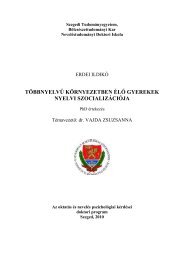

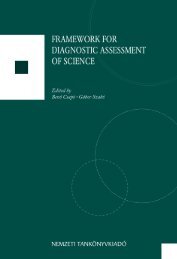
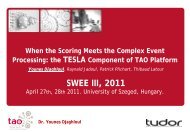
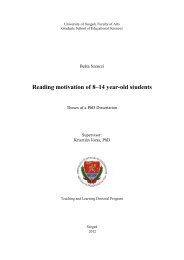

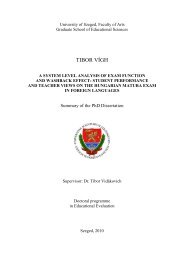
![Download [PDF] - Diagnosztikus Mérések Fejlesztése](https://img.yumpu.com/38928685/1/177x260/download-pdf-diagnosztikus-macracsek-fejlesztacse.jpg?quality=85)
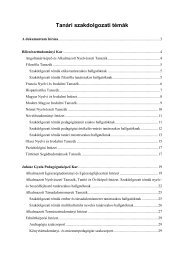


![Download [PDF] - Diagnosztikus Mérések Fejlesztése](https://img.yumpu.com/38928622/1/180x260/download-pdf-diagnosztikus-macracsek-fejlesztacse.jpg?quality=85)
